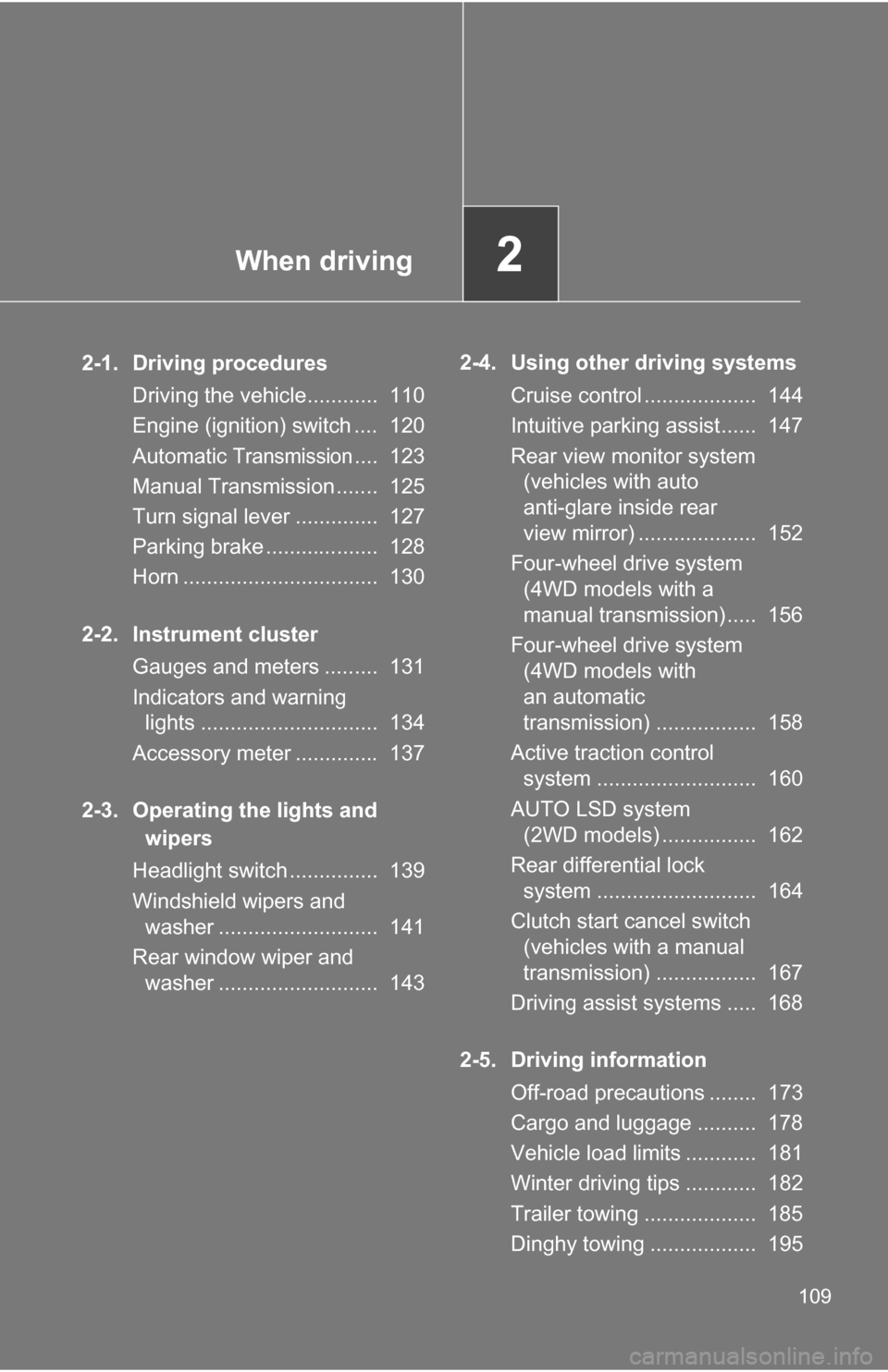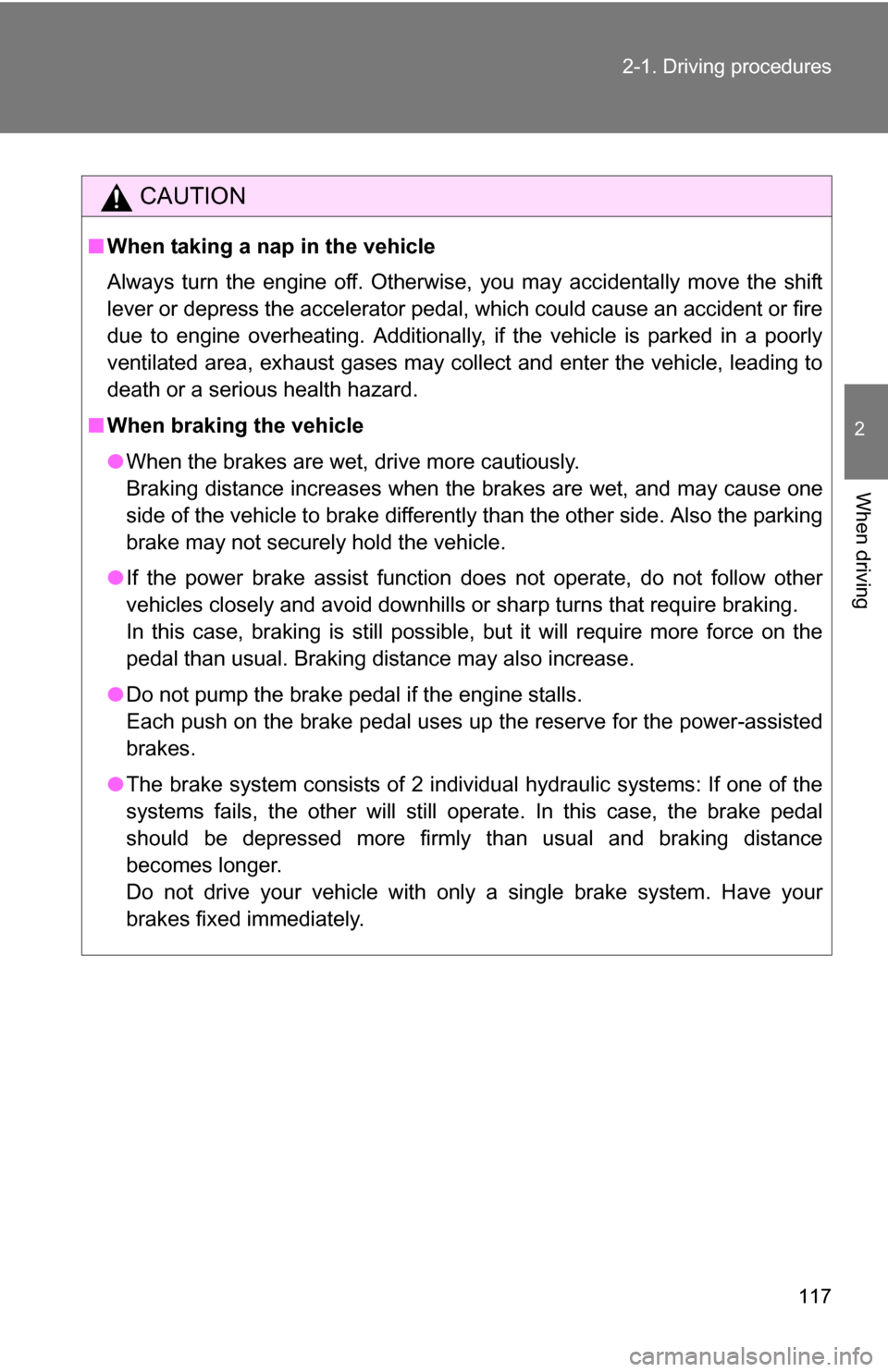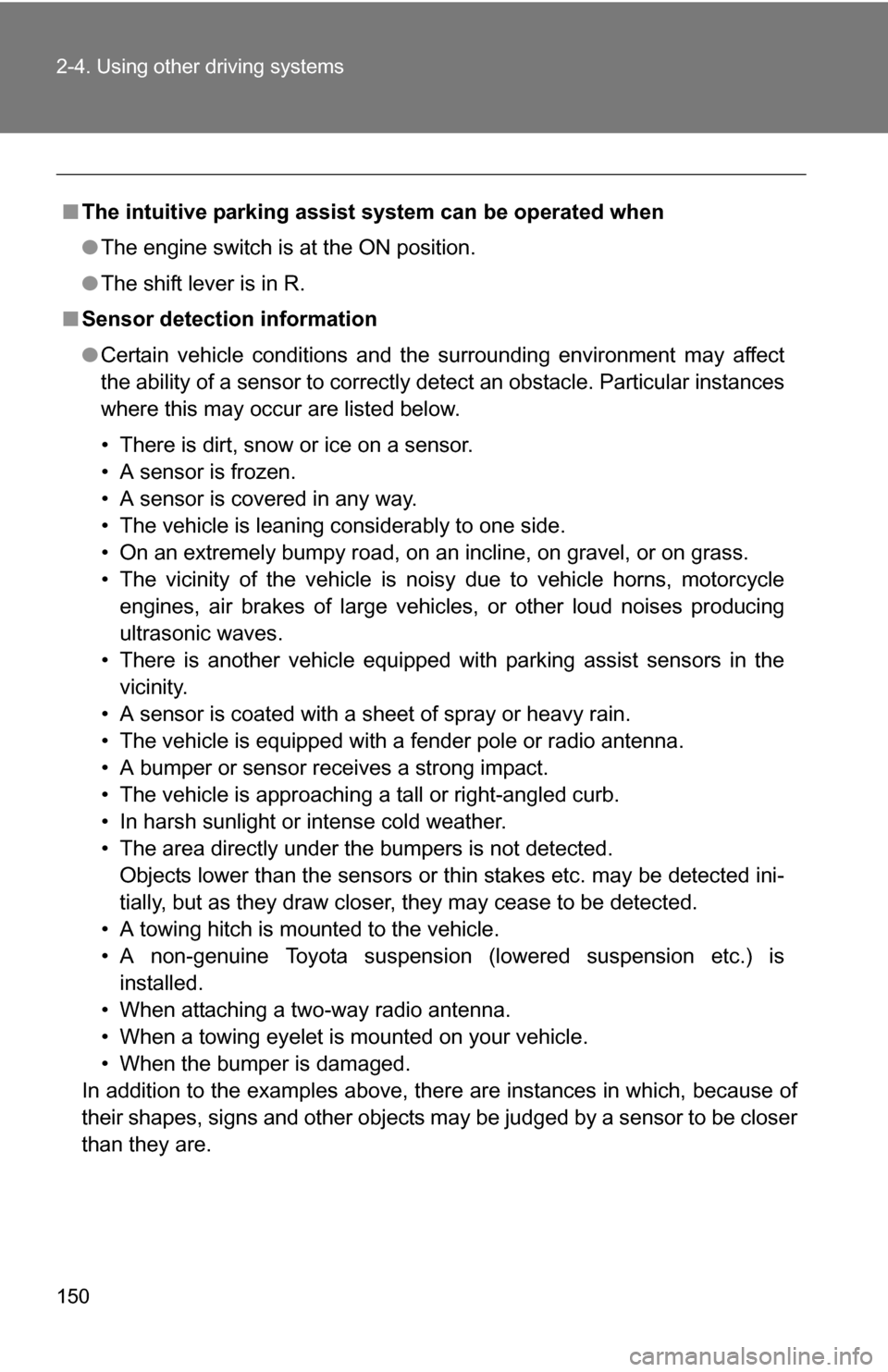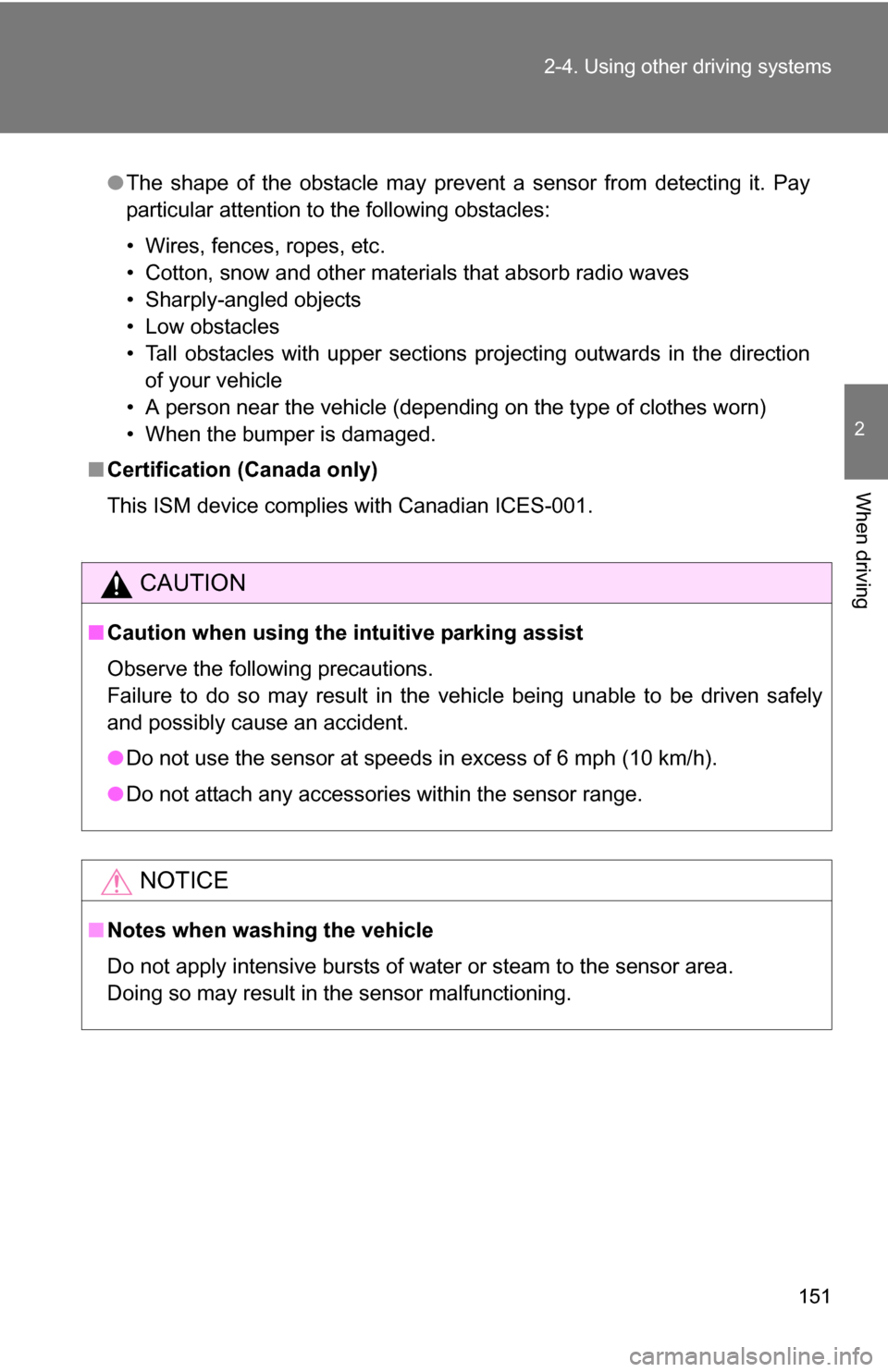Page 3 of 432

1
2
3
4
5
6
7
3
Rear window wiper and washer .............................. 143
2-4. Using other driving systems Cruise control ...................... 144
Intuitive parking assist......... 147
Rear view monitor system (vehicles with auto anti-glare
inside rear view mirror) ..... 152
Four-wheel drive system (4WD models with a manual
transmission) .................... 156
Four-wheel drive system (4WD models with an
automatic transmission) .... 158
Active traction control system .............................. 160
AUTO LSD system (2WD models) ................... 162
Rear differential lock system .............................. 164
Clutch start cancel switch (vehicles with a manual
transmission) .................... 167
Driving assist systems ........ 168
2-5. Driving information Off-road precautions ........... 173
Cargo and luggage ............. 178
Vehicle load limits ............... 181
Winter driving tips ............... 182
Trailer towing ...................... 185
Dinghy towing ..................... 195 3-1. Using the air conditioning
system and defogger
Air conditioning system ...... 198
Rear window defogger ....... 204
3-2. Using the audio system Audio system types ............ 205
Using the radio ................... 208
Using the CD player ........... 214
Playing back MP3 and WMA discs ....................... 222
Optimal use of the audio system .............................. 231
Operating the sub woofer ... 234
Changing display color (type B only) ..................... 235
Using the AUX adapter....... 236
Using the steering wheel audio switches
............................. 238
3-3. Using the interior lights Interior lights list ................. 240
• Interior lights..................... 241
• Personal lights.................. 242
3-4. Using the storage features List of storage features ....... 243
• Glove box ......................... 243
• Cup holders (front) ........... 244
• Cup holders (rear) ............ 247
• Bottle holders ................... 248
• Auxiliary box ..................... 249
3Interior features
Page 16 of 432
16
Pictorial indexInstrument panel
VSC OFF switch P. 162, 169, 170
RR DIFF LOCK switch P. 164
A-TRAC switch P. 160
Power outlet main switch
P. 255
Intuitive parking assist
switch
P. 147
AUX adapter P. 236
SUB WOOFER switch P. 234
Power outlet P. 254
Page 109 of 432

When driving2
109
2-1. Driving proceduresDriving the vehicle............ 110
Engine (ignition) switch .... 120
Automatic
Transmission.... 123
Manual Transmission ....... 125
Turn signal lever .............. 127
Parking brake ................... 128
Horn ................................. 130
2-2. Instrument cluster Gauges and meters ......... 131
Indicators and warning lights .............................. 134
Accessory meter .............. 137
2-3. Operating the lights and wipers
Headlight switch ............... 139
Windshield wipers and washer ........................... 141
Rear window wiper and washer ........................... 143 2-4. Using other driving systems
Cruise control ................... 144
Intuitive parking assist...... 147
Rear view monitor system (vehicles with auto
anti-glare inside rear
view mirror) .................... 152
Four-wheel drive system (4WD models with a
manual transmission) ..... 156
Four-wheel drive system (4WD models with
an automatic
transmission) ................. 158
Active traction control system ........................... 160
AUTO LSD system (2WD models) ................ 162
Rear differential lock system ........................... 164
Clutch start cancel switch (vehicles with a manual
transmission) ................. 167
Driving assist systems ..... 168
2-5. Driving information Off-road precautions ........ 173
Cargo and luggage .......... 178
Vehicle load limits ............ 181
Winter driving tips ............ 182
Trailer towing ................... 185
Dinghy towing .................. 195
Page 117 of 432

117
2-1. Driving procedures
2
When driving
CAUTION
■
When taking a nap in the vehicle
Always turn the engine off. Otherwise, you may accidentally move the shift
lever or depress the accelerator pedal, which could cause an accident or fire
due to engine overheating. Additionally, if the vehicle is parked in a poorly
ventilated area, exhaust gases may collect and enter the vehicle, leadin\
g to
death or a serious health hazard.
■ When braking the vehicle
●When the brakes are wet, drive more cautiously.
Braking distance increases when the brakes are wet, and may cause one
side of the vehicle to brake differently than the other side. Also the parking
brake may not securely hold the vehicle.
● If the power brake assist function does not operate, do not follow other
vehicles closely and avoid downhills or sharp turns that require braking.
In this case, braking is still possible, but it will require more force on the
pedal than usual. Braking distance may also increase.
● Do not pump the brake pedal if the engine stalls.
Each push on the brake pedal uses up the reserve for the power-assisted
brakes.
● The brake system consists of 2 individual hydraulic systems: If one of the
systems fails, the other will still operate. In this case, the brake pedal
should be depressed more firmly than usual and braking distance
becomes longer.
Do not drive your vehicle with only a single brake system. Have your
brakes fixed immediately.
Page 147 of 432
147
2-4. Using other driving systems
2
When driving
Intuitive parking assist (if equipped)
The distance to obstacles measured by the sensors is communi-
cated via the buzzer when parallel parking or maneuvering into a
garage. Always check the surroundi ng area when using this system.
■Back sensors
These sensors detect obsta-
cles behind the vehicle.
Page 148 of 432
148 2-4. Using other driving systems
The distance and buzzerWhen a sensor detects an obstacle, the buzzer sounds.
■ Intuitive parking assist switch
ON/OFF
When on, the buzzer sounds
to inform the driver that the
system is operational. At this
time, the indicator will come
on.
Press the button to switch the
ON/OFF mode.
Distance shown
as 4.9 to 3.3 ft.
(150 to 100 cm)3.3 to 1.6 ft.
(100 to 50 cm)1.6 ft.
(50 cm)
BuzzerMedium Fast Continuous
Page 150 of 432

150 2-4. Using other driving systems
■The intuitive parking assist system can be operated when
●The engine switch is at the ON position.
● The shift lever is in R.
■ Sensor detection information
●Certain vehicle conditions and the surrounding environment may affect
the ability of a sensor to correctly detect an obstacle. Particular instances
where this may occur are listed below.
• There is dirt, snow or ice on a sensor.
• A sensor is frozen.
• A sensor is covered in any way.
• The vehicle is leaning considerably to one side.
• On an extremely bumpy road, on an incline, on gravel, or on grass.
• The vicinity of the vehicle is noisy due to vehicle horns, motorcycle
engines, air brakes of large vehicles, or other loud noises producing
ultrasonic waves.
• There is another vehicle equipped with parking assist sensors in the vicinity.
• A sensor is coated with a sheet of spray or heavy rain.
• The vehicle is equipped with a fender pole or radio antenna.
• A bumper or sensor receives a strong impact.
• The vehicle is approaching a tall or right-angled curb.
• In harsh sunlight or intense cold weather.
• The area directly under the bumpers is not detected. Objects lower than the sensors or thin stakes etc. may be detected ini-
tially, but as they draw closer, they may cease to be detected.
• A towing hitch is mounted to the vehicle.
• A non-genuine Toyota suspension (lowered suspension etc.) is installed.
• When attaching a two-way radio antenna.
• When a towing eyelet is mounted on your vehicle.
• When the bumper is damaged.
In addition to the examples above, there are instances in which, because of
their shapes, signs and other objects may be judged by a sensor to be closer
than they are.
Page 151 of 432

151
2-4. Using other
driving systems
2
When driving
.
●The shape of the obstacle may prevent a sensor from detecting it. Pay
particular attention to the following obstacles:
• Wires, fences, ropes, etc.
• Cotton, snow and other materials that absorb radio waves
• Sharply-angled objects
• Low obstacles
• Tall obstacles with upper sections projecting outwards in the direction
of your vehicle
• A person near the vehicle (depending on the type of clothes worn)
• When the bumper is damaged.
■ Certification (Canada only)
This ISM device complies with Canadian ICES-001.
CAUTION
■Caution when using the intuitive parking assist
Observe the following precautions.
Failure to do so may result in the vehicle being unable to be driven safely
and possibly cause an accident.
●Do not use the sensor at speeds in excess of 6 mph (10 km/h).
● Do not attach any accessories within the sensor range.
NOTICE
■Notes when washing the vehicle
Do not apply intensive bursts of water or steam to the sensor area.
Doing so may result in the sensor malfunctioning.